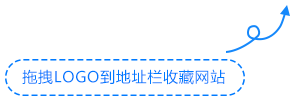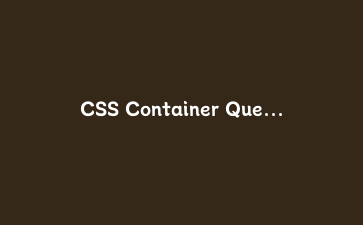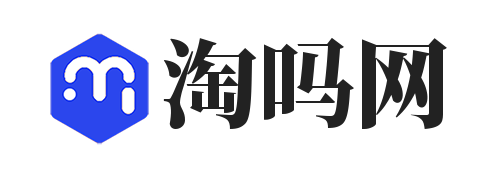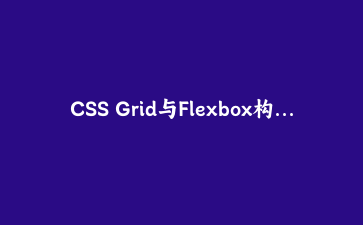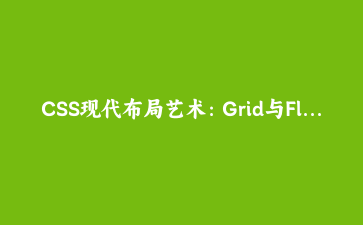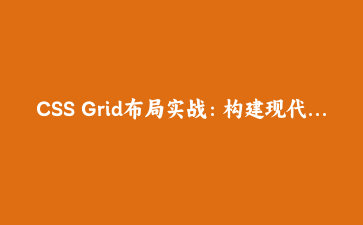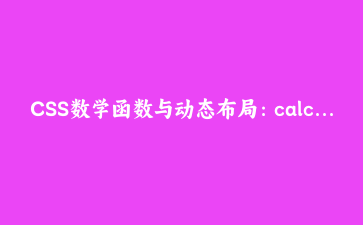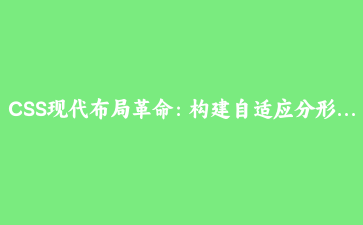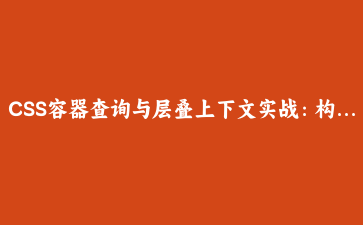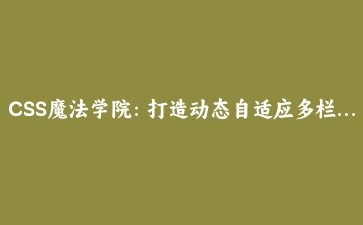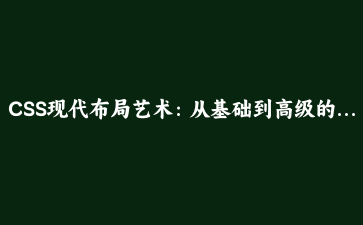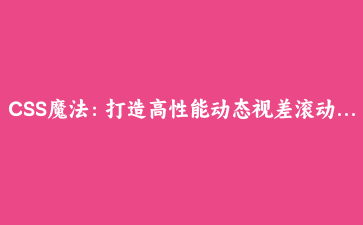超越传统媒体查询的新一代响应式设计技术
发布日期:2024年1月
阅读时间:15分钟
一、容器查询技术概述
CSS Container Queries是近年来CSS领域最重要的创新之一,它彻底改变了我们实现响应式设计的方式。与基于视口尺寸的媒体查询不同,容器查询允许组件根据其容器的尺寸来调整样式,真正实现了组件级的响应式设计。
技术背景与发展
在传统响应式设计中,我们主要依赖媒体查询来根据屏幕尺寸调整布局。然而,这种方法存在明显局限性:
- 组件无法感知其所在容器的实际空间
- 相同的组件在不同布局中表现不一致
- 需要大量重复的媒体查询代码
容器查询的出现解决了这些问题,让组件真正实现了”自适应性”。
二、与传统媒体查询的对比分析
媒体查询的局限性示例
/* 传统媒体查询方式 */
.product-card {
display: flex;
flex-direction: column;
}
@media (min-width: 768px) {
.product-card {
flex-direction: row;
}
}
/* 问题:无论卡片在什么容器中,都遵循相同的断点 */容器查询的优势
/* 容器查询方式 */
.product-card {
container-type: inline-size;
}
@container (min-width: 400px) {
.product-card {
flex-direction: row;
}
}
/* 优势:组件根据自身容器尺寸自适应 */| 特性对比 | 媒体查询 | 容器查询 |
|---|---|---|
| 作用范围 | 全局视口 | 特定容器 |
| 组件复用性 | 低 | 高 |
| 代码维护性 | 复杂 | 简洁 |
| 设计灵活性 | 有限 | 极高 |
三、基础语法与配置详解
1. 定义容器
首先需要将元素声明为容器,支持三种容器类型:
.container {
/* 尺寸容器 - 基于尺寸变化 */
container-type: inline-size;
/* 布局容器 - 基于布局变化 */
container-type: size;
/* 样式容器 - 基于样式变化 */
container-type: style;
/* 容器名称(可选) */
container-name: main-container;
}
/* 简写方式 */
.container {
container: main-container / inline-size;
}2. 容器查询语法
@container (min-width: 400px) {
.component {
/* 当容器宽度 ≥ 400px 时的样式 */
}
}
@container main-container (max-width: 300px) {
.component {
/* 针对特定容器的查询 */
}
}
/* 组合查询条件 */
@container (min-width: 300px) and (max-width: 600px) {
.component {
/* 范围查询 */
}
}3. 查询特性支持
- 尺寸特性:width, height, inline-size, block-size
- 方向特性:orientation
- 样式特性:自定义属性查询
四、卡片组件实战案例
下面我们通过一个完整的产品卡片组件来演示容器查询的实际应用。
HTML结构
<div class="card-container">
<article class="product-card">
<div class="card-image">
<img src="product.jpg" alt="产品图片">
</div>
<div class="card-content">
<h3 class="product-title">产品名称</h3>
<p class="product-description">产品描述信息...</p>
<div class="product-meta">
<span class="price">¥299</span>
<button class="buy-btn">立即购买</button>
</div>
</div>
</article>
</div>CSS容器查询实现
/* 基础卡片样式 */
.product-card {
container-type: inline-size;
container-name: product-card;
border: 1px solid #e1e5e9;
border-radius: 12px;
overflow: hidden;
background: white;
}
/* 小尺寸容器(< 300px) */
@container product-card (max-width: 299px) {
.product-card {
display: flex;
flex-direction: column;
padding: 12px;
}
.card-image img {
width: 100%;
height: 120px;
object-fit: cover;
border-radius: 8px;
}
.product-title {
font-size: 14px;
margin: 8px 0 4px;
}
.product-description {
display: none; /* 小尺寸隐藏描述 */
}
.product-meta {
display: flex;
justify-content: space-between;
align-items: center;
margin-top: 8px;
}
}
/* 中等尺寸容器(300px - 500px) */
@container product-card (min-width: 300px) and (max-width: 499px) {
.product-card {
display: grid;
grid-template-columns: 120px 1fr;
gap: 16px;
padding: 16px;
}
.card-image img {
width: 100%;
height: 100px;
object-fit: cover;
border-radius: 8px;
}
.product-title {
font-size: 16px;
margin-bottom: 8px;
}
.product-description {
font-size: 14px;
color: #666;
line-height: 1.4;
display: -webkit-box;
-webkit-line-clamp: 2;
-webkit-box-orient: vertical;
overflow: hidden;
}
.product-meta {
display: flex;
justify-content: space-between;
align-items: center;
margin-top: 12px;
}
}
/* 大尺寸容器(≥ 500px) */
@container product-card (min-width: 500px) {
.product-card {
display: flex;
gap: 24px;
padding: 24px;
}
.card-image {
flex: 0 0 200px;
}
.card-image img {
width: 100%;
height: 150px;
object-fit: cover;
border-radius: 12px;
}
.card-content {
flex: 1;
display: flex;
flex-direction: column;
}
.product-title {
font-size: 20px;
margin-bottom: 12px;
}
.product-description {
font-size: 16px;
line-height: 1.6;
color: #444;
flex: 1;
}
.product-meta {
display: flex;
justify-content: space-between;
align-items: center;
margin-top: 16px;
}
.price {
font-size: 24px;
font-weight: bold;
color: #e53935;
}
.buy-btn {
padding: 12px 24px;
background: #1976d2;
color: white;
border: none;
border-radius: 6px;
cursor: pointer;
font-size: 16px;
}
}五、布局系统重构实战
使用容器查询重构传统的网格布局系统,实现真正的自适应组件。
传统网格布局的问题
/* 传统方式需要多个媒体查询 */
.grid-item {
width: 100%;
}
@media (min-width: 640px) {
.grid-item { width: 50%; }
}
@media (min-width: 1024px) {
.grid-item { width: 33.333%; }
}
@media (min-width: 1280px) {
.grid-item { width: 25%; }
}容器查询解决方案
.grid-container {
container-type: inline-size;
container-name: grid-layout;
display: grid;
gap: 16px;
}
/* 根据容器宽度自动调整列数 */
@container grid-layout (min-width: 200px) {
.grid-container {
grid-template-columns: repeat(auto-fit, minmax(200px, 1fr));
}
}
@container grid-layout (min-width: 600px) {
.grid-container {
grid-template-columns: repeat(auto-fit, minmax(250px, 1fr));
gap: 24px;
}
}
@container grid-layout (min-width: 900px) {
.grid-container {
grid-template-columns: repeat(auto-fit, minmax(280px, 1fr));
gap: 32px;
}
}
/* 网格项内部使用嵌套容器查询 */
.grid-item {
container-type: inline-size;
}
@container (min-width: 300px) {
.grid-item .content {
display: flex;
gap: 16px;
}
}六、高级应用技巧与最佳实践
1. 容器查询与CSS自定义属性结合
.component {
container-type: inline-size;
--layout-mode: vertical;
}
@container (min-width: 400px) {
.component {
--layout-mode: horizontal;
}
}
.component .item {
display: flex;
flex-direction: var(--layout-mode);
}2. 性能优化建议
- 避免过度使用容器查询,只在必要时使用
- 合理设置容器类型,inline-size性能优于size
- 使用具名容器提高查询效率
- 结合CSS Containment优化渲染性能
3. 浏览器兼容性处理
/* 渐进增强方案 */
.product-card {
/* 基础样式,所有浏览器支持 */
display: flex;
flex-direction: column;
}
/* 支持容器查询的浏览器应用增强样式 */
@supports (container-type: inline-size) {
.product-card {
container-type: inline-size;
}
@container (min-width: 400px) {
.product-card {
flex-direction: row;
}
}
}4. 调试技巧
/* 调试容器边界 */
.debug-container::after {
content: '容器宽度: ' attr(data-container-width);
position: fixed;
top: 10px;
right: 10px;
background: rgba(0,0,0,0.8);
color: white;
padding: 5px;
border-radius: 4px;
font-size: 12px;
}总结与展望
CSS Container Queries标志着响应式设计进入了一个新的时代。通过将响应式逻辑从全局视口转移到组件容器,我们能够创建出真正自适应的、可复用的UI组件。
核心优势总结:
- 真正的组件级响应式设计
- 大幅提升代码复用性和维护性
- 更直观的设计系统实现
- 更好的性能表现
随着浏览器支持的不断完善,容器查询必将成为现代Web开发的标准实践。建议在项目中逐步引入这一技术,为未来的Web开发做好准备。
